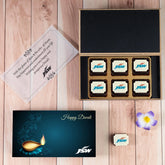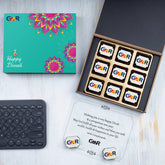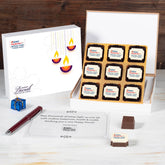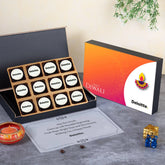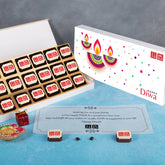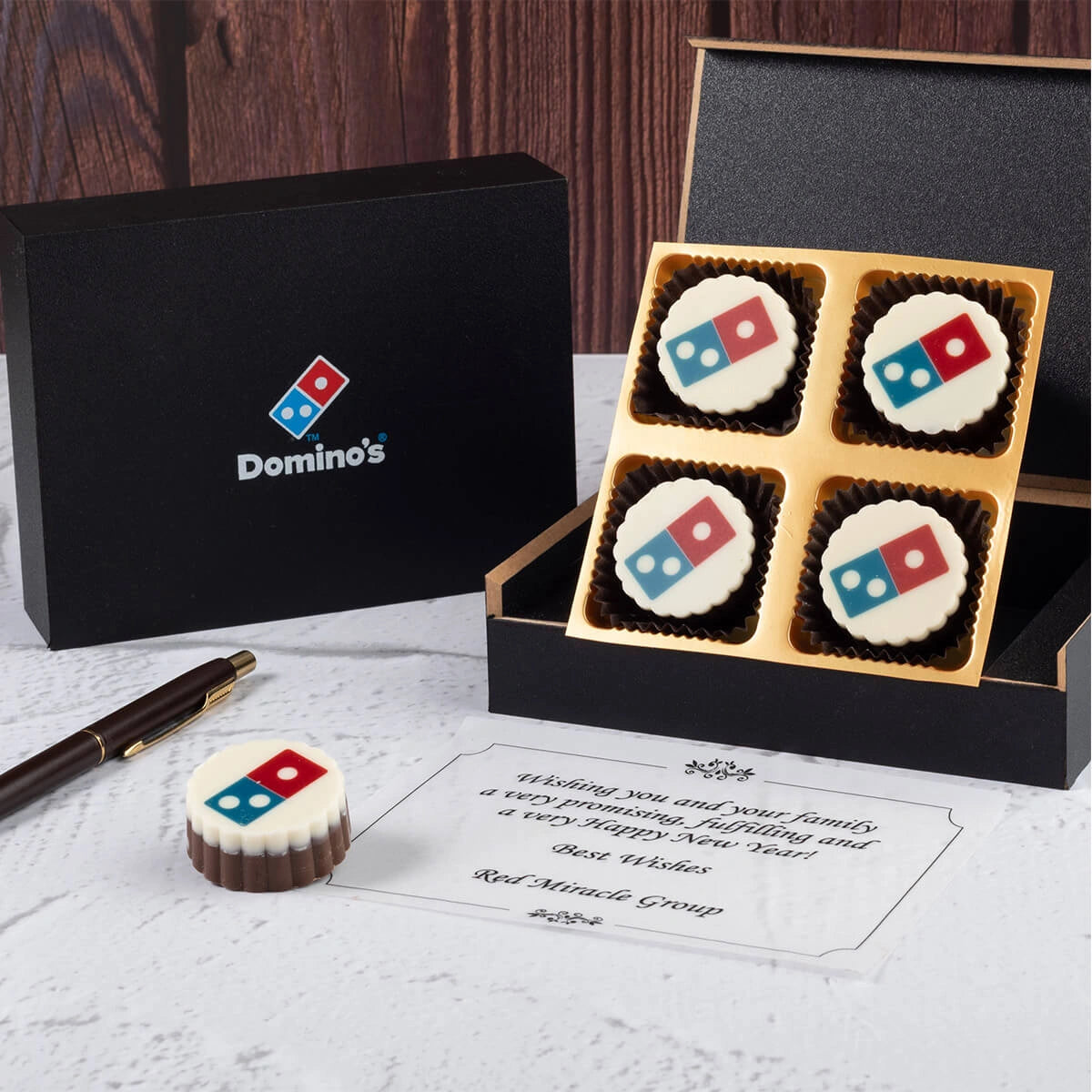The Psychology of Appreciation: Why Gifts Trump Verbal Praise for ROI
The Psychology of Appreciation: Why Gifts Trump Verbal Praise for ROI
Explore Corporate Gifting
Key Takeaways
-
Employee gifting is not just an expense — it’s a strategic investment that can drive morale, retention, and brand loyalty when done right.
-
Premium gifts build long-term emotional connections and enhance the employer brand, while budget-friendly gifts work best for large-scale distribution.
-
The ideal approach is a hybrid gifting strategy, using premium gifts for high-impact moments and cost-effective options for regular recognition.
-
ROI is not just about upfront cost — long-term benefits like reduced attrition and stronger advocacy can outweigh the initial investment.
-
Personalisation plays a critical role in making any gift — premium or budget — more impactful and memorable.
Introduction: Beyond “Thank You” – The Business Case for Tangible Appreciation
A simple “thank you” can warm someone’s heart for a moment. But in business, where engagement, retention, and performance are tied to the bottom line, appreciation needs to do more than just feel good—it must deliver a measurable return on investment (ROI).
Studies show that recognition is one of the most powerful drivers of employee engagement. But here’s the twist: tangible appreciation gifts consistently outperform verbal praise in sustaining motivation, boosting morale, and strengthening long-term loyalty. This isn’t about replacing heartfelt words—it’s about reinforcing them in a way that endures.
In India, the corporate gifting market has grown into a multi-crore industry. From corporate Diwali gifts to milestone awards, organizations are realizing that a well-chosen gift doesn’t just express gratitude—it shapes culture and boosts ROI.
At ChocoCraft, we’ve seen this firsthand. Our employee gifting ROI approach blends psychology with premium printed chocolates, transforming appreciation into a tangible, lasting memory.
----------------------------------------------------------------------
The Science of Appreciation: Why Gifts Work
Appreciation is a core human need. Psychologists note that recognition boosts “psychological ownership”—the feeling of being valued and belonging to an organization.
While verbal praise triggers short-term motivation, appreciation gifts create a physical reminder of that moment. This tangibility is powerful because:
- Keepsake factor – Employees can revisit the feeling every time they see or use the gift.
- Symbolic value – A personalized gift becomes a badge of belonging.
- Social signaling – When employees display their gifts, it signals recognition to peers, creating a culture of achievement.
According to O.C. Tanner, companies with strategic recognition programs see a 31% reduction in voluntary turnover and 21% higher productivity—figures that verbal praise alone rarely achieves.
Premium Corporate Gifts with Logo Chocolates
Make a lasting impression on clients and employees with personalized chocolate gift boxes that reflect your brand.
Explore Now
----------------------------------------------------------------------
The Neuroscience of Tangible Rewards
While appreciation has an emotional component, it also has a measurable neurological impact. Neuroscience studies reveal that receiving a physical gift activates the brain’s reward pathways—specifically the release of dopamine and oxytocin. Dopamine fuels motivation and the desire to repeat positive behaviors, while oxytocin builds trust and strengthens social bonds.
Verbal praise alone triggers a smaller, shorter dopamine spike that quickly returns to baseline. In contrast, tangible gifts offer a multi-sensory experience that reactivates the reward pathway each time the recipient sees, uses, or remembers the gift. This repeated stimulation sustains motivation over weeks or even months.
Moreover, the hippocampus—the brain’s memory center—links the moment of gift-giving with positive emotional context. This means employees are more likely to recall the specific achievement and the company’s role in recognizing it. In workplace psychology, this is known as “anchored motivation,” where the physical token becomes a mental anchor to the moment of success.
Organizations that leverage neuroscience-backed gifting strategies can enhance retention and engagement without significantly increasing spend—making the business case even stronger. When recognition is rooted in both psychology and brain science, it transforms from a one-time gesture into a sustained performance driver.
Focus on gifts that strengthen engagement: personalized chocolates boost brand recall and retention. Read more →
----------------------------------------------------------------------
Gifts vs. Words: The ROI Debate
Verbal praise is essential—it’s immediate, personal, and free. But it also fades quickly from memory. In contrast, gifts:
- Are permanent reminders of the recognition moment.
- Often have a higher perceived value than their actual cost.
- Strengthen emotional connection to the organization.
In a Deloitte/Bersin study, companies that integrated tangible recognition saw significant increases in employee engagement scores, particularly in competitive industries where retention is a challenge.
Imagine this: You congratulate an employee in a meeting, and they smile. Now imagine you also hand them a beautifully packaged corporate gift box with their name and a personalized chocolate design. Weeks later, that box sits on their desk, still reminding them of their contribution.
----------------------------------------------------------------------
The Morale Boost Multiplier
Employee morale is like a battery—it needs regular recharging. Gifts amplify that recharge because they tap into multiple senses: sight, touch, and sometimes even taste.
For example, ChocoCraft’s printed chocolate boxes combine personalized designs with delicious flavors, delivering both an emotional and sensory experience. This multi-layered impact keeps morale high long after the initial recognition moment.
In a survey by Advertising Specialty Institute, 70% of employees said receiving a gift made them feel more connected to their company, compared to just 38% for verbal praise alone.
----------------------------------------------------------------------
Psychological Triggers Behind Effective Appreciation Gifts
Understanding the psychology behind gifting can help HR and marketing leaders maximize ROI:
- Reciprocity Principle – When employees receive something of value, they feel motivated to give back in effort and loyalty.
- Scarcity Effect – Limited-edition or customized gifts feel more exclusive, increasing perceived value.
- Endowment Effect – People value items more when they feel personally connected to them, such as personalized chocolates or engraved keepsakes.
- Novelty Boost – Unexpected gifts, especially outside of traditional occasions, have a stronger impact.
Premium Corporate Gift Box
Stylish and elegant chocolate boxes crafted to leave a lasting impression on your clients.
Explore Now
----------------------------------------------------------------------
Real-World Example: The Q2 Target Win
One of our clients, a leading fintech company, faced slipping mid-year morale. Instead of waiting for Diwali, they surprised their top performers with customized chocolate gift boxes in July. Each box carried the employee’s name, the company logo, and a motivational quote.
The result? Engagement survey scores jumped 18% the following quarter, and project delivery rates improved by 12%.
----------------------------------------------------------------------
How to Choose Appreciation Gifts that Deliver ROI
Not all gifts are created equal. To maximize return:
- Personalization is key – Add names, company logos, or personal messages.
- Quality over quantity – A premium gift leaves a better impression than a pile of low-cost items.
- Usefulness matters – Choose items employees will use or display.
- Brand alignment – Gifts should reflect your brand’s identity and values.
ChocoCraft’s premium chocolate boxes meet these criteria by blending personalization, elegance, and practicality.
----------------------------------------------------------------------
Avoiding Gifting Pitfalls: What Not to Do
A poorly executed gifting strategy can do more harm than good. While the intention behind appreciation gifts is positive, missteps can lead to disappointment or even resentment.
Common pitfalls include:
-
Overly generic gifts: Mass-produced, unbranded items that feel impersonal may send the message that recognition is just a checkbox activity.
-
Low-quality items: A flimsy gift can undermine the perception of the company’s commitment to quality.
-
Irrelevant choices: Gifts that don’t align with employees’ lifestyles or interests risk going unused, losing both utility and emotional impact.
-
Unequal distribution: If recognition gifts are given inconsistently or perceived as unfair, they can breed workplace tension.
To avoid these pitfalls, HR leaders should adopt a feedback-driven approach. Conduct short surveys to learn employees’ preferences, track usage of past gifts, and adjust choices based on the data.
In addition, timing is critical. A delayed gift, far removed from the achievement it’s meant to honor, dilutes the emotional connection. Best practice is to give within days of the achievement—while enthusiasm and pride are still high.
In short, successful gifting requires the same thoughtfulness you’d apply to marketing campaigns: audience insights, quality control, and a clear objective.
Select an agency that offers full customization, mockup previews, and reliable delivery. Read more →
----------------------------------------------------------------------
India’s Corporate Gifting Trends & Benchmarks
In India, around 25% of companies spend ₹500–₹2,000 per employee annually on gifts, while another 23% spend under ₹500. However, the ROI sweet spot often comes from balancing perceived value with cost-effectiveness.
Trending gift types in India:
- Personalized edible gifts (premium chocolates, sweets)
- Branded desk accessories
- Wellness hampers
- Eco-friendly products
For festivals like corporate Diwali gifting, premium personalized chocolates have emerged as a standout choice—memorable, shareable, and visually appealing.
----------------------------------------------------------------------
Best Practices for Implementing an Appreciation Gift Program
- Integrate with recognition culture – Gifts should complement, not replace, verbal praise.
- Plan the calendar – Don’t wait for year-end; recognize achievements throughout the year.
- Leverage milestone moments – Work anniversaries, project completions, and personal celebrations.
- Surprise & delight – Occasional unexpected gifts create buzz.
- Track impact – Use surveys, retention rates, and productivity metrics to measure ROI.
4 Piece Premium Client Gift Box
A compact yet elegant chocolate box designed for exclusive corporate gifting.
See Collection----------------------------------------------------------------------
Linking Appreciation to Customer-Facing Teams
While this blog focuses on employees, the same principles apply to clients. A corporate gift for customers can cement relationships, improve repeat business, and enhance brand perception.
For example, gifting personalized chocolates to a client post-project can reinforce goodwill and open doors for future deals.
----------------------------------------------------------------------
The ROI Equation: Making the Business Case
Let’s break it down:
- Cost per employee gift: ₹1,200
- Annual retention gain: 5% reduction in attrition
- Average replacement cost per employee: ₹1.5 lakh
- Net savings: Multiple times the investment per head
This makes gifting not just a morale boost strategy, but a cost-saving and revenue-generating tactic.
----------------------------------------------------------------------
ChocoCraft’s Role in High-Impact Appreciation
ChocoCraft specializes in customized corporate gifts—especially printed chocolates in elegant keepsake boxes. From 2-chocolate mini boxes to 18-piece luxury sets, we create experiences that employees remember and share.
Our clients use them for:
- Quarterly recognition programs
- Festival gifting
- Sales target celebrations
- Client thank-you gifts
----------------------------------------------------------------------
The Digital Edge: Integrating Tech with Appreciation
In today’s hybrid and remote work environments, appreciation strategies must bridge physical and digital worlds. Technology offers powerful tools to make gifting more impactful, personalized, and measurable.
Personalized gifting platforms now allow HR teams to automate delivery, customize messages, and track engagement. For example, a digital dashboard can record which employees have received gifts, what types they prefer, and even their responses—helping refine future campaigns.
AR and QR code integration adds an interactive layer. Imagine a premium chocolate box where scanning the code reveals a personalized video message from the CEO or a highlight reel of the employee’s contributions. This transforms a physical gift into a hybrid recognition experience, amplifying emotional resonance.
E-gift portals can also give employees the choice to select their preferred items within a curated catalog. Choice increases perceived value and reduces the risk of unused gifts, while still maintaining brand alignment.
By combining thoughtful physical gifts with digital touchpoints, companies can extend the appreciation moment across channels. This hybrid approach works especially well for geographically dispersed teams, ensuring everyone experiences recognition simultaneously, regardless of location.
The future of corporate gifting lies in blending tradition with innovation—keeping the emotional weight of a tangible gift, while leveraging technology to scale and personalize the experience.
Compare vendors by product range, customization, logistics, and feedback before choosing. Read more →
----------------------------------------------------------------------
Closing: The Gift-Plus-Pride Culture
At its heart, the psychology of appreciation is about making people feel seen, valued, and integral to the organization’s journey. Words spark the feeling; gifts keep it alive.
By embedding thoughtful, personalized gifts into your recognition strategy, you’re not just boosting morale—you’re investing in loyalty, productivity, and a positive brand culture.
As one CEO told us after a company-wide gifting program:
“It wasn’t just the chocolates—it was the message that we care enough to make it personal.”
If you want to turn appreciation into a strategic ROI driver, explore ChocoCraft’s range of corporate gifts for employees and see how a little sweetness can make a big difference.
----------------------------------------------------------------------
Key Information
| Aspect | Premium Employee Gifts | Budget-Friendly Employee Gifts |
|---|---|---|
| Perceived Value | High perceived value, enhances brand prestige | Lower perceived value, practical but less memorable |
| Impact on Morale | Strong emotional connection, higher satisfaction | Positive but may fade quickly |
| Retention Benefits | Encourages loyalty and long-term commitment | May have limited impact on retention |
| Brand Positioning | Positions company as premium and employee-centric | Positions company as cost-conscious |
| Customisation | More scope for personalization and exclusivity | Limited customization due to cost |
| ROI Potential | Higher long-term ROI through loyalty and advocacy | Immediate cost savings but lower lifetime value |
| Best Use Case | Recognizing top performers, milestone celebrations | Mass gifting, onboarding welcome kits |
FAQs
-
Why are appreciation gifts more effective than verbal praise?
Gifts create a tangible reminder of appreciation and can reinforce the emotional impact longer than words alone—especially when personalized. -
Does employee gifting really improve ROI?
Yes—recognition programs show strong ROI via lower attrition (≈31%) and higher engagement (≈21% for ₹250 spend/employee) -
What is psychological ownership and why does it matter?
It’s the feeling of ‘belongingness’ to the organization fostered through meaningful recognition, which increases commitment and discretionary effort. -
Can verbal praise work at all?
Absolutely—especially when sincere and timely—but its effects may be shallow and short-lived if repeated without variation. -
How much do Indian companies spend on employee gifts?
Approximately 25% spend ₹500–2,000 per employee annually, while 23% spend up to ₹500. -
What types of gifts offer best ROI in India?
Practical, branded items like caps, power banks, notebooks, T-shirts, and little desk knick-knacks tend to drive high social media engagement and internal value. -
How often should organizations gift employees?
Frequent, personalized touches (e.g., quarterly or milestone gifts) are more impactful than rare, large-scale rewards. -
Can gifting improve engagement long-term?
Yes—when tied into a broader recognition culture, gifts function as reinforcing loops between appreciation and motivation. -
Do gifts boost brand loyalty internally?
Definitely—70% of businesses indicate gifting enhances brand loyalty, reinforcing organizational identity. -
What makes a good appreciation gift?
It should be relevant, personalized (logo, name), useful, and delivered with authentic recognition to maximize emotional and behavioral impact.

Author Bio
The blog is written and compiled by Saurabh Mittal and his team using intelligent tools.
Entrepreneur Saurabh Mittal founded ChocoCraft where they print your logo, message, or photo on premium chocolate which are presented in an elegant custom wooden box with a message for the recipient. Since 2013, ChocoCraft has worked with 2,500+ companies with logo chocolate gifts for occasions like Diwali, client outreach, onboarding, milestone events, and global campaigns. The brand’s reach also extends to over 1,00,000 B2C customers across India, who choose ChocoCraft to celebrate life’s personal moments like Birthdays, Anniversaries, Rakshabandhan and others. Read more about us ›

